Most mornings I'm an early riser, up well before sunrise, reading a book in our quiet little kitchen until the sun comes up. But there's one resident of our street who beats me to it every morning. This person.

The koel. Everyone in Sydney knows this bird
not so much by sight as by sound. This black
bird, the male koel, calls for his mate from early
in the morning, like 3am or 4am early, and goes
on with his call all day, at this time of year.
This one creature causes more lost sleep than
any other living thing in Sydney.
http://www.garden.canberrabirds.org.au/sounds/cuckoos/commonKoel.mp3
Epic post ahead warning! Keep on reading this longish blog posting from here only if you are interested in finding out probably everything I know about birds in my backyard.
Now, for starters, credit where credit is due, and my theft confessed to with humble apologies. I have pinched virtually all photos used in this posting, and all the sound recordings, from the excellent Birds of Canberra website, found here http://www.garden.canberrabirds.org.au
I have long wanted to do a posting on the birds which regularly visit our garden, and have proved to be such an inept photographer of them that when I visited the excellent Birds of Canberra website I discovered that they happened to have most of the birds which visit my backyard, here on the NSW coast. Canberra might be well inland and south of Sydney, but it's still only 288km away from here, not that far away as the birds fly.
And so I can at last do my (epic) posting on birds which visit our garden. The list is longish yet that doesn't mean these birds are here every day, though all the following birds are seen here throughout the year, some very regularly. And thanks again to the excellent ornithologists of Canberra for their wonderful work.
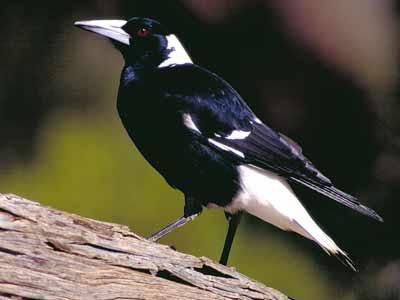
The magpie. Often heard and seen here, one of the
most beautiful calls of all, and my favorite.
http://www.garden.canberrabirds.org.au/sounds/butcherBirdsEtc/australianMagpie.mp3
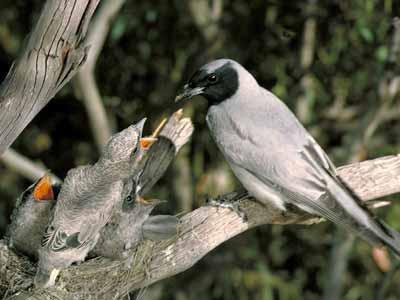
The black faced cuckoo shrike, named by early colonists.
It's neither a cuckoo nor a shrike, though. Nice looking bird,
often seen on the clothesline or TV aerial looking for food.
http://www.garden.canberrabirds.org.au/sounds/cuckooShrikesEtc/bfCuckooShrike.mp3

My favorite personality in the garden is this little bird. It's the
New Holland Honeyeater and it's a small thing but it's fast,
smart and fearless. I've seen dopey big wattlebirds try to
chase New Hollands out of 'their' grevillea, but the New
Holland just darts here, there, up down and the selfish big
wattlebird never wins even a point in their scraps.
http://www.garden.canberrabirds.org.au/sounds/honeyeaters/newHollandHE.mp3
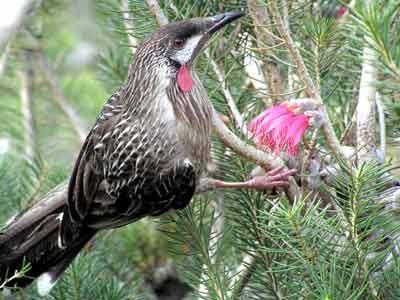
Here's the aforementioned greedy dope, the Red Wattlebird.
I actually like this flighty creature. That red 'flap' on its cheek
is called a 'wattle', and so it doesn't get its name from wattle
trees. This is an early riser too, often feeding on the flowering
gum tree which is our street tree. It's the only native bird we
have a nickname for, and I call him or her 'Cluck', as that's
what its call sounds like, which goes like this...
http://www.garden.canberrabirds.org.au/sounds/honeyeaters/redWattlebird.mp3
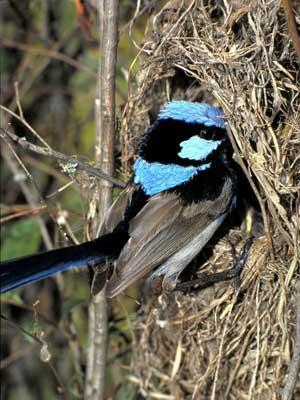
Lots of people call this a Blue Wren, for obvious
reasons, but only the males are blue, and as Mrs
Wren is brown, the 'correct' name of Superb Fairy
Wren is a better description. These little insect eaters
are tiny and get about the garden in a pretty little
hoppity hoppity way. One little thing I like about these
wrens is that the male juveniles are brown, like
their mums. When they grow up and start to color up as
blue, Dad drives them off. "Clear off son, you're blue."
http://www.garden.canberrabirds.org.au/sounds/fairyWrens/superbFairyWren.mp3

Kookaburras aren't plentiful here but I do see them from time
to time. The impressive thing about these birds is their size,
they're hefty birds, strong with a big beak that's perfectly capable
of picking up an unsuspecting snake. As a child I can recall
hearing kookaburra calls being used in Tarzan movies!
http://www.garden.canberrabirds.org.au/sounds/kookaburras/laughingKookaburra.mp3
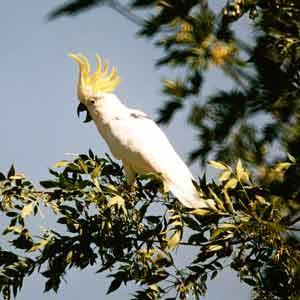
I hate seeing these squawky, destructive hoons sitting on the
fence. These Sulphur Crested Cockatoos are big birds too,
so they just do as they please. A while ago, after I had planted
out a whole bed full of vegie and flower seedlings, one of these
birds came down, walked around the bed ripping seedlings out
of the ground, looking for worms wriggling underneath. The
only thing I like about these birds is their waddling walk, and
seeing them fly off into the distance, of course.
http://www.garden.canberrabirds.org.au/sounds/cockatoos/sulphurCrestedCockatoo.mp3
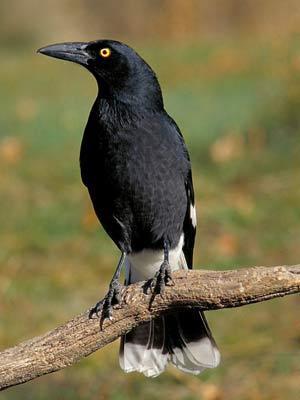
With its impressively fearsome big, black beak
the Pied Currawong visits only occasionally,
but it's always a wonderful big thing to behold.
Shame it eats bird babies so much, but it has
to make a living and that's its job.
http://www.garden.canberrabirds.org.au/sounds/butcherBirdsEtc/piedCurrawong.mp3
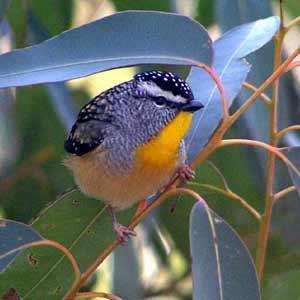
This tiny and extremely pretty little bird, the Spotted Pardalote,
is a rare visitor to our garden, and when Pam saw the first one
we were genuinely excited. We do see them a few times each year,
but each visit is a special occasion. We suspect they nest down
at the local golf course, which is nearby and sited on a river,
the kind of habitat our bird book says Spotted Pardalotes prefer.
http://www.garden.canberrabirds.org.au/sounds/tBills/spottedPardalote.mp3
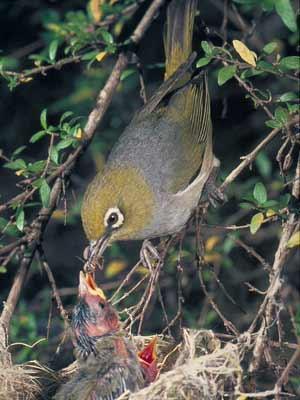
Alas, so very plentiful when we first arrived here
21 years ago, these Silvereyes are now a rarity
here, but I do occasionally see one still. A small
bird with a striking white ring around its eye
it's a busy, chatty little personality.
http://www.garden.canberrabirds.org.au/sounds/tBills/silvereye.mp3
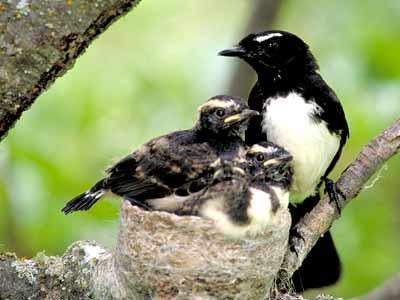
Another lovely personality is the Willie Wagtail, a smallish fantail
bird who waggles that tail as it looks for insects and grubs.
While a common bird in general, its visits here are just occasional.
http://www.garden.canberrabirds.org.au/sounds/sittellasetc/willieWagtail.mp3

With an appalling screech of a call that's like fingernails on a
blackboard to me, the Peewee or Magpie Lark has won back
my sympathy, as I have learned that it is a common dupe for
the cuckoo-style tricks of that annoying koel which wakes up so
many people. Koels lay their eggs in Peewee nests, and when
the baby koel hatches it pushes all the Peewee babies out of the nest
(to their doom) and then the Peewee parents exhaust themselves
trying to keep up food supplies to the huge, ever-hungry koel baby.
Ain't nature cruel sometimes!
http://www.garden.canberrabirds.org.au/sounds/sittellasetc/aMagpieLark.mp3
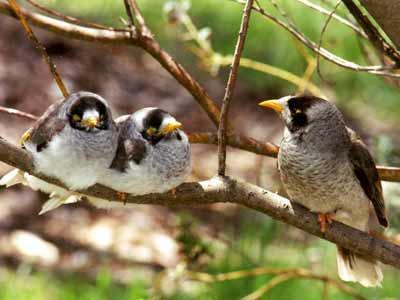
I'm caught between admiration and dislike of this bird, the Noisy
Miner, which is plentiful on the street side of our house, and
mercifully not so often seen in our backyard. I admire them for
their unlimited reserves of bravery as they fight birds two, three
or more times their size (in packs). But they are bully birds
who just live to dominate their territory and constantly try to
shoo away 'intruders'. Their natural habitat is 'forest margins',
ie, trees on the edge of a forest, with light scrub or grasslands
beyond, and that's a hell of a lot like parkland and suburbia,
so they are in huge numbers here in Sydney. They don't really
like our backyard as it's too densely planted for their liking. Phew!
http://www.garden.canberrabirds.org.au/sounds/honeyeaters/noisyMiner.mp3
Almost finished, but not quite. All photos and bird calls featured above are from the Canberra Birds website, but they didn't have every bird which visits our garden, so here's a few more. Continuing my ignoble tradition of thieving both bird photos and recordings of their calls, I have proceeded to the wonderful 'Birds in Backyards' website for these next items. It can be found athttp://www.birdsinbackyards.net
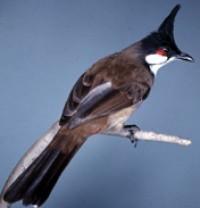
This Red-Whiskered Bulbul isn't a native bird
but one family lives here. Every year Mr and Mrs
Bulbul make a nest in our Murraya hedge and
raise babies. I am proud to say that my keen
mulching of our garden with sugar cane mulch
provides some very suitable nesting materials.
Interestingly, I spotted Mr Bulbul the other day
having an all-in fight with himself. He was perched
on the end of our barbecue, flapping his wings
and pecking madly at our garden mirror, in which
he could see his reflection. Hope he didn't hurt himself,
but I do think the reflection came off second-best.
http://www.birdsinbackyards.net/species/Pycnonotus-jocosus
And finally, the last and most colourful backyard visitor of all of all is this person, the rainbow lorikeet, in a photo taken by me (the only one in this posting, I am sorry to say).
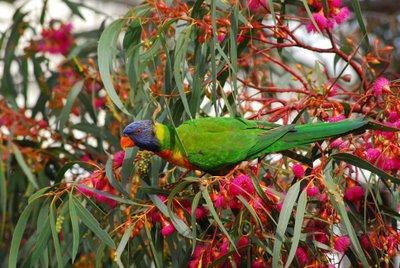
The rainbow lorikeet, pictured in his favorite spot, our
Eucalyptus leucoxylon 'Rosea' street tree. This tree flowers
from early autumn to late spring, and the rainbow lorikeets,
red wattlebirds and New Holland Honeyeaters are in
constant competition for the abundant nectar on offer.
And again, courtesy of Birds in Backyards, a fact sheet on these birds which includes their not especially pleasing call
http://www.birdsinbackyards.net/species/Trichoglossus-haematodusAnyone still here? Working from home allows Pammy and me to keep a good, close eye on who visits here, and we never ever tire of our little fun with birdwatching. The one lesson that keeps on popping up from all this bird visiting and watching is that though it may be small, my little backyard is an important little bit of habitat that helps to sustain many hundreds of important, beautiful and sometimes wonderful to behold little lives.
